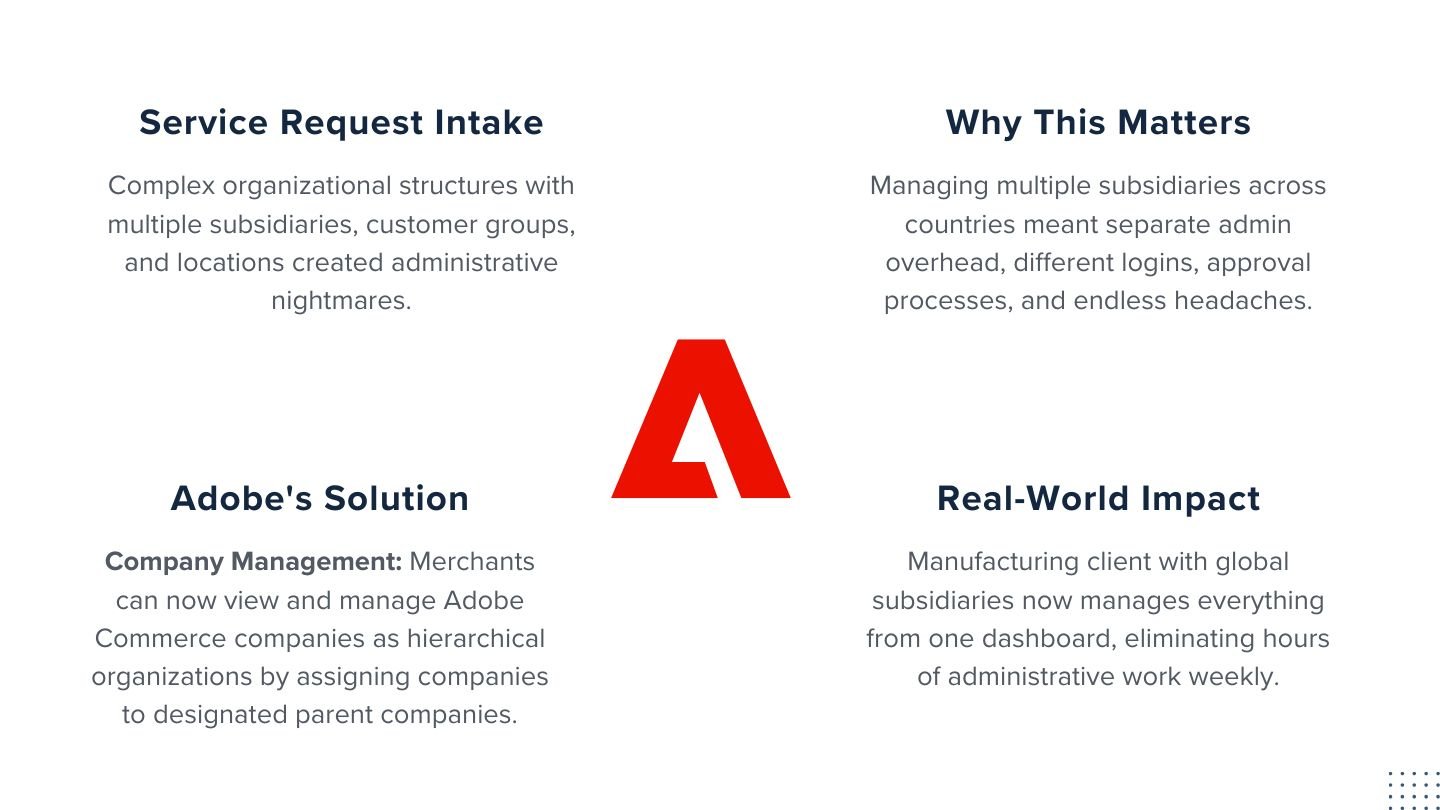The B2B eCommerce world is changing fast. Really fast.
If you’re a manufacturer, distributor, or wholesaler trying to figure out which platform will actually help your business grow (not just look pretty), you’ve probably been overwhelmed by all the marketing noise out there.
Here’s the thing: after spending the last few months diving deep into Adobe Commerce B2B 1.5 and Shopware’s latest B2B Components, I’ve realized that both platforms are solving very different problems. And choosing the wrong one could cost you serious time and money.
Let’s break down what really matters for your business.
- The B2B Reality Check
- Adobe Commerce B2B 1.5: Finally Getting Hierarchy Right
- Adobe Commerce and the Digital Experience Advantage
- Adobe Commerce as a Cloud Service: The Architecture Shift
- Shopware: Building for Tomorrow's Commerce
- Technical Stuff That Actually Matters
- What the Numbers Tell Us
- How to Actually Choose Between Them
- Here's What It Really Comes Down To
The B2B Reality Check
Here’s a stat that should get your attention: Gartner predicts that 80% of B2B sales interactions between suppliers and buyers will occur in digital channels by 2025. That’s massive.
But here’s what most platform vendors won’t tell you. Most B2B companies are still struggling with systems that weren’t built for this reality. They’re trying to force complex organizational structures, approval workflows, and pricing hierarchies into platforms designed for simple retail transactions.
That’s where the real battle is happening.
Adobe Commerce B2B 1.5: Finally Getting Hierarchy Right

The Multi-Company Problem (And Why It Matters)
If you’re managing multiple subsidiaries, different customer groups, or complex organizational structures, Adobe’s latest release might just save your sanity.
Here’s what they’ve done: Company Management – Merchants can now view and manage Adobe Commerce companies as hierarchical organizations by assigning companies to designated parent companies. After a company is assigned to a parent, the parent company administrator can manage the company account.
We recently worked with a manufacturing client who has subsidiaries across multiple countries. Before this update, each subsidiary needed separate admin overhead. That meant different logins, different approval processes, different headaches for each location.
Now? They manage everything from one dashboard. It sounds simple, but this change eliminates hours of administrative work every week.
Quote Management That Actually Works
Let’s talk about quotes for a second. If you’re in B2B, you know that quoting is often where deals live or die. Adobe’s improvements here are pretty solid.
Now buyers can save quotes as drafts when creating a quote request from the shopping cart, so they can review and update it before initiating the quote negotiation process with the seller.
But here’s what we think is even more important: Updated Commerce Access Control List (ACL) rules allow B2B managers and supervisors to manage quotes and quote templates of subordinate users. Separate rules support granular configuration for view, edit, and delete access.
Translation? Your sales managers can finally oversee their team’s quotes without micromanaging every single interaction. That’s huge for companies with complex approval processes.
The Platform Strategy Shift
Adobe made a big strategic move: one full core patch release per year with an expanded three-year support window while delivering new features as independent SaaS services.
What does this mean for you? Stability. Predictability. No more constant platform updates disrupting your operations. For large enterprises that can’t afford frequent platform disruptions, this is exactly what they needed.
Adobe Commerce and the Digital Experience Advantage
While we’ve talked about Adobe Commerce’s B2B features, here’s what makes it truly different from other B2B platforms: Adobe Commerce doesn’t exist in isolation. It’s part of Adobe’s broader Digital Experience suite.
If you’re already using Adobe Analytics for deep customer insights, Adobe Target for personalization, or Adobe Campaign for marketing automation, Adobe Commerce integrates seamlessly with these tools. And we’re talking about opportunities that go way beyond what most B2B platforms can even dream of offering.
Here’s what this looks like in practice: You can use Adobe Analytics data to create laser-targeted customer segments in Adobe Commerce. Then leverage Adobe Target to personalize product recommendations and pricing displays based on customer behavior across every single touchpoint. Adobe Campaign can then nurture leads and customers with automated email sequences that reference their specific commerce interactions.
For large enterprises already invested in the Adobe ecosystem, this creates customer experience sophistication that standalone commerce platforms simply can’t match. It’s not just about buying and selling – it’s about creating cohesive customer journeys that actually convert.
This is particularly powerful for B2B companies with longer, more complex sales cycles where nurturing prospects and providing personalized experiences can make the difference between winning and losing deals. And trust me, that difference shows up in your bottom line.
Adobe Commerce as a Cloud Service: The Architecture Shift
But here’s where Adobe is taking a different approach: Adobe Commerce as a Cloud Service (ACCS). This represents a significant departure from their traditional model.
ACCS shifts to a “locked core” SaaS model – similar to Shopify’s infrastructure but maintaining enterprise-grade flexibility. The core application code now stays locked and is only accessible to Adobe, which changes how customizations work.
The key difference: instead of traditional platform modifications, ACCS uses “out-of-process extensibility” through Adobe App Builder. This separates customizations from the core platform, which should reduce maintenance overhead.
The App Builder Advantage
With App Builder, developers can build secure and scalable apps that extend Adobe Commerce’s native functionality and integrate with third-party solutions without touching the core platform. Think of it like this: you get the best of both worlds – Shopify’s simplicity with enterprise customization capabilities.
We recently helped a client evaluate ACCS for their complex B2B operation. What impressed us most? The platform features elastic auto-scaling that automatically adjusts resources to meet peak demands, plus automatic updates that give you 30 days to evaluate them in your sandbox before they’re applied to production.
Why This Matters for B2B
Here’s the practical implication: traditional Adobe Commerce customizations often break during upgrades. With ACCS, your customizations run “out-of-process” through App Builder, which should provide better stability during platform updates.
For B2B companies, this addresses a real operational issue. You can build complex approval workflows, custom pricing engines, and integration layers that remain functional when Adobe releases updates. That’s enterprise-grade functionality with SaaS-style maintenance.
The platform aims to combine Shopify-like convenience with Magento’s scalability and control – which could be valuable for large B2B operations that need both flexibility and reliability.
Shopware: Building for Tomorrow’s Commerce
Agentic Commerce (Yes, It’s Actually Happening)

Shopware is betting big on something they call “Agentic Commerce.” At their recent special event, they unveiled a visionary outlook on the future of digital commerce with exciting new features and a strong focus on B2B.
While Adobe is solving today’s enterprise problems, Shopware is building for a future where AI agents handle routine commerce tasks automatically. And we’ve seen this working in real implementations.
Picture this: AI agents that automatically generate product recommendations, process routine reorders, and even negotiate basic pricing within set parameters. It’s not science fiction anymore.
The Modular Revolution
Here’s where Shopware gets interesting. Instead of forcing you to buy everything upfront, they’ve created a modular approach: Key components ready for immediate use include ‘B2B Quick Order Options,’ ‘B2B Employee Management’, ‘B2B Quote Management and ‘B2B Approval Rules & Rights Management’.
This modular framework features a range of customizable B2B functionalities, enabling merchants to tailor each element to their specific needs, with granular configuration capabilities down to individual users and roles.
A recent client only needed employee management and quote functionality initially. They saved 40% on licensing costs while keeping the ability to add features as they grow. That’s the kind of flexibility most businesses need but rarely get.
Now let’s talk about two Shopware features that show why they’re thinking differently about B2B commerce:
Shopware’s Digital Sales Rooms: Personalizing the Sales Experience
One feature that really sets Shopware apart is their Digital Sales Rooms. This isn’t just another B2B feature – it’s a complete rethinking of how sales teams work with buyers online.
Think about it: most B2B sales still happen through a combination of emails, phone calls, PDFs, and eventually an eCommerce transaction. Digital Sales Rooms create a dedicated space where sales reps can collaborate with buyers, share custom presentations, manage documents, and guide the entire sales process in a personalized environment.
Working alongside Digital Sales Rooms is the Sales Agent – a cutting-edge tool within the B2B Components suite designed to centralize all sales activities in one place. It offers a tailored overview of customer interactions, appointment scheduling, and the creation of quotes and orders.
Together, these tools solve a huge problem we see everywhere: the disconnect between digital commerce and how sales teams actually work. Instead of forcing your sales team to adapt to the platform, Shopware’s approach works with their existing processes.
For B2B companies where relationship selling matters – which is most of them – this creates the kind of tailored experience that buyers expect but rarely get from traditional eCommerce platforms.
Shopware’s Rule Builder: Business Logic Without Code
Here’s another area where Shopware shines: their Rule Builder functionality. The Approval Rules & Rights Management is part of the Shopware B2B Components. It allows you to set up differentiated approval workflows and tailor user-level permissions for accessing B2B functionalities.
B2B commerce is full of complex “if this, then that” scenarios. Different pricing for different customer tiers. Approval workflows that change based on order size. Shipping rules that vary by region and product type. Payment terms that depend on customer history.
Traditionally, you’d need developers to code these rules. Shopware’s Rule Builder lets business users create and modify these workflows themselves. That means faster implementation, easier changes, and less dependency on technical resources.
This isn’t just about convenience. In B2B, business rules change frequently. Market conditions shift. New customer segments emerge. Regulatory requirements evolve. Having the ability to adapt your commerce rules quickly can be a real competitive advantage.
Technical Stuff That Actually Matters
Shopware 6.7’s upcoming release brings some real technical improvements: A major shift from Webpack to Vite will modernize the frontend toolchain and full compatibility with Vue 3 will be achieved by moving out of compatibility mode. Migration from Vuex to Pinia for state management.
Why should you care? These changes mean your development team will be more productive and your long-term maintenance costs will be lower. That’s money back in your pocket.
What the Numbers Tell Us
Today, over 60% of Shopware merchants run a dedicated B2B business or combine B2B and B2C, including well-known brands like Toyota, Ritter Sport, and Beijer Ref.
That growth tells me their modular approach is working for mid-market and growing enterprises.
Adobe Commerce? They still own the large enterprise space, especially where complex organizational hierarchies and established enterprise software ecosystems require proven integration capabilities.
How to Actually Choose Between Them
After working with both platforms across dozens of implementations, here’s how we think about this decision:
Go with Adobe Commerce if:
- You have complex subsidiary relationships that need unified management
- Enterprise-grade quote approval workflows are business-critical
- Three-year platform stability windows align with your planning cycles
- Your budget supports higher total cost of ownership for proven enterprise features
Go with Shopware if:
- You want modular architecture and prefer paying only for features you use
- AI-driven commerce automation aligns with your future vision
- Development team velocity and modern technical stack are priorities
- You’re building for rapid scaling and changing requirements
Here’s What It Really Comes Down To
Both platforms are making serious investments in B2B functionality. But they’re solving different problems.
Adobe Commerce is perfecting enterprise hierarchy management with sophisticated organizational tools and proven scalability. They’re the safe choice for large enterprises that need everything to work perfectly from day one.
Shopware is pioneering the next generation of AI-driven, modular commerce experiences. They’re the choice for companies that want to build for tomorrow’s commerce landscape.
The choice isn’t really about features. It’s about philosophy and where your business is headed.
Here’s what we’ve learned: the most successful implementations happen when platform philosophy aligns with how your organization actually works and where you’re going. Both Adobe Commerce and Shopware offer strong B2B solutions, but for very different types of businesses.
The B2B eCommerce revolution isn’t waiting for perfect platforms. It’s happening now. The question is: which platform will help you get there faster?
Need help choosing the right platform for your B2B business? Let’s talk about your specific challenges and goals.
Sources:
- Adobe Commerce B2B Release Notes: Official Documentation
- Shopware B2B Components Guide: Technical Documentation
